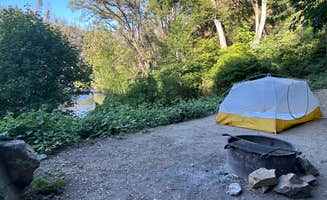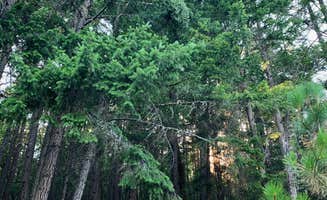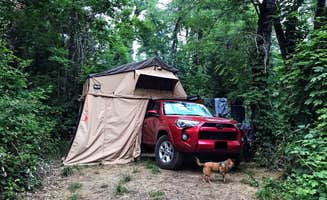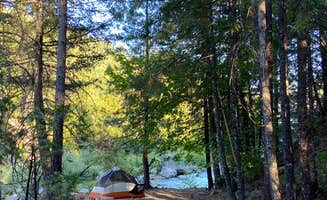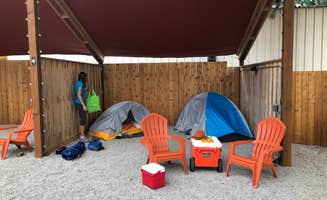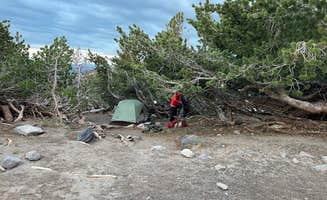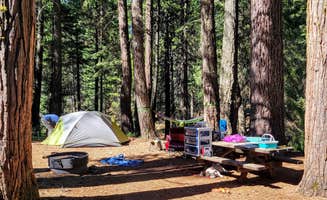Tent camping near Sugarloaf, California offers several primitive options within Shasta-Trinity National Forest at elevations ranging from 1,500 to 3,500 feet. The area features distinct seasonal access patterns, with winter snow often closing higher elevation sites while valley locations remain accessible year-round. Summer temperatures can reach into the 90s at lower elevations while higher sites maintain cooler conditions even during peak season.
What to do
Swimming in alpine lakes: Castle Lake Dispersed Camping provides direct access to cool mountain waters. One camper reports: "There's a small creek you can bushwhack to to the east, and castle lake is a 30 min walk up the road."
Boat rentals at Pine Cove Marina: Located about 10 minutes from Mary Smith Campground, the marina offers affordable kayak and boat rentals. A visitor noted: "About 10 minutes passed the campground is pine cove marina where you can rent out boats, and kayaks. They have very reasonable prices!"
Wildlife observation: The forests surrounding Crystal Creek Primitive Campground offer excellent wildlife viewing opportunities. As one camper experienced: "About 3am something woke me up sniffing around my hammock. I was not able to see it without moving, but it bumped me and was large enough to make the hammock sway."
What campers like
Secluded creekside sites: Peltier Bridge Primitive Campground features well-spaced tent pads along flowing water. "Each spot was decent. #6, 8, and 9 probably your best bets if they are open. 4 and 5 are right next to the entrance," reports one camper. Another adds: "There's like 9 or so sites all pretty far apart. The creek is super beautiful."
Mountain views: Tent sites at higher elevations provide dramatic vistas of the surrounding peaks. A camper at Greens Creek Boat-in Campground shared: "A simple little spot. There are tables there and shady spots for the tents. It's quiet and if it just rained there is the sound of waterfalls around there."
Temperature variations: Lower elevation sites can be quite warm during summer days but cool rapidly at night. "It was super warm when we went out (96 degrees) the water was very enticing," reported one Mary Smith Campground visitor, while another noted: "Gets pretty cold at night."
What you should know
Campsite terrain: Many tent sites in the region feature uneven ground requiring careful setup. At Mary Smith Campground, "The sites are sloped. It's not bad though. The views are incredible as the sun is rising, peaking through the mountains glistening over the lake."
Vehicle access considerations: Some dispersed camping areas require appropriate vehicles. A visitor to Castle Lake Dispersed Camping advised: "I would probably not recommend with a trailer. I made it down with my Tacoma and a 12ft travel trailer but it was a stretch. Super easy to get in, but took a long time to turn around and get back out."
Wildlife precautions: Proper food storage is essential throughout the area. As one Crystal Creek camper discovered: "I put my food in the locker, and I'm very glad I did. About 3am something woke me up sniffing around my hammock."
Tips for camping with families
Site selection for children: Choose sites with flat areas for play. At Jones Valley Inlet Shoreline Campground, "It's a well maintained site and it was nice and quiet. Some decently shaded areas as well."
Access to water features: Some sites require substantial walking to reach swimming areas. One Mary Smith visitor noted: "We stayed at site 14, across from us was a small path that lead you down to the water. We took tubes out and laid in the water and soaked up the sun."
Bathroom considerations: Facilities vary widely between established and primitive sites. "Pit toilets are very clean!" reports one Peltier Bridge camper, while others mention "no lights" in bathroom facilities at Mary Smith Campground.
Tips from RVers
Road conditions: Access roads to many tent camping areas present challenges for larger vehicles. A Castle Lake visitor reported: "Road dips down but rutted and I'm low clearance so can't tell what's down there. I'm in the only pullout off the side of the road before it dips."
Alternative parking strategies: When RV sites are unavailable, consider nearby parking. "Anything bigger than and you're probably stuck," warns a Castle Lake camper about trailers, suggesting tent camping with separate vehicle parking may be necessary.
Seasonal access limitations: Spring access often depends on snow melt. One Castle Lake visitor noted in late May: "There isn't access to some areas as there is snow blocking the way, some areas are wet from the snow that has already melted."


